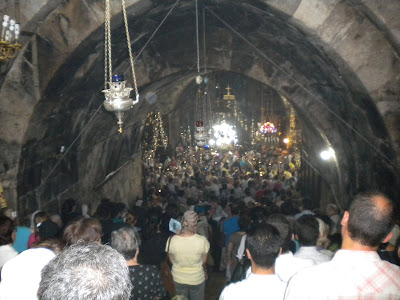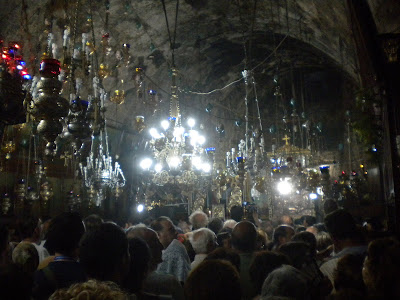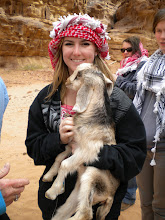After I wrote about going into to Jerusalem, I decided it would be ok to skip a couple days on my blog; after all, how much could really happen? I regret that decision now because I have done SO many interesting things in the time since I don’t know how I am going to write about all of them without sacrificing at least a few important details.
After going through the checkpoint security, Tata Huda, Jiries and I drove into Jerusalem to visit the church with the tomb of the Virgin Mary. There must have been nearly a thousand people inside the church- there were stairs, completely covered with people, just inside the entrance leading down to the grotto where the tomb is located. On both sides of the stairs were decorative shrines surrounding the tombs of Mary’s mother and father. It was sweltering hot inside of the church, everyone was wildling waving fans in their faces but the sweat dripping down each individual forehead was hard to miss. There were lots of Greek Orthodox nuns, who cover their whole bodies in all black loose robes- they look just like Muslims, except they wear a hat under their headscarf. Tata Huda and I walked halfway down the stairway, then gave up and went back outside. We met with Jiries, who had been down the road parking the car, and then we sat in the shade for a few minutes before attempting again to make it all the way down into the grotto.









Our second try was more successful in the sense that we made it all the way down to the bottom of the steps to where the site of the tomb is. It was less successful, however, in that at one point I was convinced that I was going to be crushed to death by the mob of people surrounding me or the unbearable heat was going to get me. There were priests milling about the crowd, wearing long black robes with funny tall black hats, and loads on gold chains with huge crosses at the end. In front of the tomb the priests were taking turn shouting the mass, and when they announced the communion would be served, the crowd surged forward. Jiries, Tata Huda and I were squished all the way through a bottleneck pathway to the other side of the tomb, where we found a bunch of fat-cat clergy members lounging around- in AIR CONDITIONING!
The tomb of one of Mary’s parents:







Decorations on the tomb of Mary:

Imagine how hot it was down there:


The way back was even more brutal since we were fighting against the crowd. Once we made it back outside, we visited another building where the Greek Orthodox patriarch was hanging out. The Greek Orthodox Church is the mother of all Christian churches in Jerusalem, so the patriarch is basically the Christian spokesperson, or very much like the pope of Jerusalem. Jiries dislikes him because he is Greek, and not Arab, and also because the Greek Orthodox clergy is extremely wealthy, which seems a bit hypocritical. I went over and shook his hand and said Keefak? (how are you) and he seemed very intrigued by me. He had some American general with disturbingly red eyes, whose name I didn’t catch, sitting on one side of him and then clergy members all around him. He asked me where I was from and when I told him, an overzealous clergy member a few seats away announced he was actually from Southington, Connecticut! But, thankfully, he was called by the Lord to be with his highness holiness the patriarch, and he is grateful for every second that he is in his presence, and he thinks of him every second he is away from him in the church in Moscow that his highness stationed him at. Ok… that was weird.




I couldn’t figure out who he was worshipping more, God or the patriarch. The patriarch was talking to someone else so I turned to leave, but the Patriarch said hey you, come back, and stand next to me for a while. I looked over at Jiries like, what do I do?? He laughed, shrugged, and walked away. I was tempted to ask the patriarch why he sold East Jerusalem to the Israelis, ultimately betraying the Arabs who he represents but really has no emotional connection to, but I refrained. The conversation waned and I was eventually pushed out by more devoted followers.

After that we walked around the Garden of Gethsemane. In case you need a quick Bible lesson memory-jog, the Garden of Gethsemane is where Jesus prayed on the rock when he was afraid because he knew he was going to die soon, and he told the disciples to stay awake while he prayed, but when he came back from the rock he found them all fast asleep. We visited the Garden on the Tree of Life trip this year, and David (the FCCOL minister) gave an inspiring sermon that underlined a correlation between the sleeping disciples and the “sleeping” churches which sometimes turn a blind eye to the social injustices happening in the world- especially in Palestine. Jiries and I admired the ancient olives trees that were planted even before Jesus was born and the Bible says he prayed under before his death.









On the way home we went through a different checkpoint, which we are not supposed to do, because Tata Huda was exhausted. The worst that could happen is that the soldiers would check our IDs, see Tata’s permit, and make us go back around to the other checkpoint to go through the same security labyrinth back into the West Bank. Fortunately for us, Jiries smiled and said “Shalom!” and they let us through without any questions.
A couple hours later I got ready and went to Bethlehem to meet Marian Sa’adeh and her parents at a wedding they invited me to. I wrote briefly about Marian in a previous post- she will be coming to the U.S. in November for the Tree of Life Conference. She is 23 years old and incredibly active in peace-making efforts as well as projects related to her own personal interest, cognitive psychology. The bride was the cousin of Marian’s mother Najwa. It was in an Assyrian Christian Church, so they recite prayers out loud in Aramaic, the language that Jesus spoke. It was a beautiful ceremony very much like the one I went to at the Nativity Church in Bethlehem a couple weeks ago.




Jiries picked me up at the end of the wedding ceremony and we went out to get falafel for dinner. The weather was perfect so we walked there.
After the checkpoint process, the church service in Jerusalem, and then the wedding, I was pretty wiped out. I took it easy Sunday and worked on another environmental report for the Palestine Wildlife Society. My break didn’t last long, however, and yesterday proved to be full of more adventures.
Monday: I was up early to go to Tata Huda’s senior citizens center (her “university”). I fought back sleepy eyes for the first hour or so but soon enough I was helping the staff and learning how to play card games with some of the older women. I think the staff really likes me now, every time I am there they ask when I will be in Beit Sahour until, and every time I tell them they seem genuinely sad to hear that I won’t be here forever. It was weird though, I have to admit, that the woman who I normally hang out with, Hind, wasn’t there because she passed away. Every single elderly woman made it a point to talk to me about how she died, and since I clearly couldn’t understand a lot of what they were saying they all took it upon themselves to actually act it out. Apparently she took her last bite of lunch, and then collapsed right there on the table. I saw several reenactments, each one more dramatic than the last.
Jiries picked me up early so I could go to another university- the University of Bethlehem. Marian and I agreed to meet there at 11:30 so she could show me around and tell me about her life there as a student and as a worker- she is project manager for a lot of things, most recently a book compiling life stories written by dozens of Palestinians. Marian introduced me to a lot of the staff and some of the students; everyone there seemed to know her. First we went out for lunch with the secretary of the Social Sciences department, then we toured the library, the cafeteria, the computer lab, the chapel, the academic halls, and all over campus outside. The university is extremely important because the Palestinians do not have access to the outside world, and almost all young people are not allowed to travel even 15 minutes away into Jerusalem.






This building, built with money from USAID, was completely destroyed by the Israelis during the Second Intifada; ironically, when they cleaned up the rubble, they found shell remnants that said “Made in the United States of America”. USAID ultimately helped them rebuild it.


The University of Bethlehem was established in 1972 as the first four year university in Palestine. It was built by an order of (church) brothers from the U.S. and supported by the Pope. The biggest departments are the business school, teacher’s college, science/nursing, and hotel management.
 From 1978 until 1981 Jiries was the head of the business/economics department, but he had to step down from his position when the Israelis forced him to choose between his job and denouncing the Palestine Liberation Organization. Because of the occupation, the university, like any other institution in the West Bank, was on the receiving end of collective punishment. This meant it could be shut down at any given time for up to several months, preventing students from entering. This started happening as soon as the school was established, but increased significantly during the Second Intifada.
From 1978 until 1981 Jiries was the head of the business/economics department, but he had to step down from his position when the Israelis forced him to choose between his job and denouncing the Palestine Liberation Organization. Because of the occupation, the university, like any other institution in the West Bank, was on the receiving end of collective punishment. This meant it could be shut down at any given time for up to several months, preventing students from entering. This started happening as soon as the school was established, but increased significantly during the Second Intifada. I saw the buildings that had been shelled by Israel during the first Intifada and then rebuilt by the Palestinians with the help of USAID. In the library there was a Palestinian National Heritage center where there was still a huge hole in the wall from one of the rockets Israel hit it with- they decided to keep the hole there to serve as a reminder of what had happened.





Pictures on display of some of the destruction:

Palestinian family from the early 1900s:

We stopped in the auditorium and listened to a student panel doing a Q&A session with a group of visitors from Germany (what we did on the TOL trip this year). Out of 5 students, only one had a blue passport which indicated she lives in Jerusalem. The rest had green passports; they need another form of identification to travel anywhere at all, a small white ID written in Hebrew which they need to reapply for every 3 years, but they can’t go into Jerusalem (or anywhere in Israel) without additional special permits obtained through the application process, which is usually complex- pretty much impossible- for young adults. They jokingly said what it comes down to is that they need permission to get permission. Marian chimed in during the presentation, since she used to be one of the students on the panel while she attended university, and pointed out how absurd the permit procedure is since there is so much security crossing the security fence/apartheid wall. There is no way anyone could get any metals or weapons into Jerusalem, so why do they need to apply for all these permits? One of the guys on the panel added that Israel claims since the construction of the wall, suicide bombings have stopped, but in reality the Palestinians and Hamas in particular denounced suicide bombing before the wall was built.
The students talked about the main checkpoints versus the flying checkpoints, which are ones that can be set up by Israeli soldiers anytime, anywhere. They basically just park a few jeeps in the middle of the road anywhere and stop any and/or every car the passes by. The green Palestinian IDs are the only ones any of the students had ever heard of in the world that list individual’s religion. They said that often times the Israelis use that information against them, especially at the flying checkpoints; for example, during Ramadan when the Muslims are rushing home from work before sundown so they can eat dinner, they Israelis often times hold them up at the makeshift checkpoints for extensive amounts of time. Similarly, around Christmas season, the Israeli soldiers do things like give all the Christian kids candy, but ignore the Muslim kids. This creates animosity between the two religions, targets children, and further divides Palestinian society.
The students reflected upon their personal experiences living life under occupation; one guy said he was almost 20 years old and he has only been to Jerusalem 3 times in his life. He said that when they go to military headquarters to apply for travel permits, many of his friends have been offered financial incentives by the Israelis to spy for them. Another girl said she hasn’t been allowed to travel at all for the last 3 years because she is a “suspected political activist”. Only Muslim men over 50 can go into Jerusalem with permits, and on Fridays during Ramadan they can go in with no permits, and only Muslim women over 45 can go in with permits.

After the presentation, Marian and I walked around. She told me lots of interesting things about the school and its social dynamics. As you can see from the pictures, all of the Muslim girls are sitting with each other in a certain part of campus; elsewhere the Muslim guys generally hung out with each other or with the Christians, who have co-ed mingling because it is not against their religion. Marian said everyone gets along; it’s just about personal preference.










Jiries picked me up from the university around 4 and we headed home. Tata Huda and Jiries’ sister Amal taught me how to make ktyiff, the Ramadan pastry that is either nuts or cheese wrapped in pancakes and heated up. They are so delicious; it’s very easy to eat lots of them. Right after that Tata Huda and I went with Shorok and her parents (Nawal and Isam- Jiries’ brother) to a baptism. It was either my fourth or fifth baptism since I’ve been here, there have been so many I can’t keep track anymore. The parents and grandparents of the baby come from several different families, so there were the most people I have ever seen at a baptism before. It took a lot longer than usual because it was so crowded, and some family drama went down on our way out. It was only 7:00 when I got home, but I was exhausted from the long day. Jiries made delicious fish for dinner and I finished the PWLS report about water.

Today I worked at the Wildlife Society until the afternoon, and then Jiries and I went into Jerusalem and met with Sahar, a young Israeli woman who will be speaking at the Tree of Life Conference in November. Sahar refused to join the Israeli military when she was drafted at the age of 18, and subsequently spent 2 months in jail and 3 months in detention as well as social alienation by friends and family. She will be telling her story at the conference with another conscientious objector, Maya Wind, who spoke for the Tree of Life Journey in March. In Jerusalem, while we were looking for a parking spot we drove past an Israeli military jeep with the back door open- inside was a young Arab man, blndfolded and handcuffed. It was an awful sight. No matter what he did, Jiries pointed out, they would NEVER treat an Israeli criminal like that.
I have to get up in a few hours for work at the Wildlife Society, so goodnight for now!


No comments:
Post a Comment